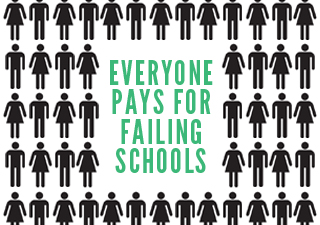Media

Pennsylvania Still Not Making the Grade
The bipartisan education reform group, StudentsFirst, released its annual State Policy Report Card grading each state’s education policies and demonstrating the need for more student-centered reforms.
How did Pennsylvania fare? Well, we got a D+.
However, other states didn’t fare much better as “D+” was the national average. StudentsFirst assessed each state’s education policies on three criteria: elevating the teaching profession, empowering parents, and whether or not a state spends wisely and governs well. Pennsylvania did not score above a “C” in any of these categories.
Why did Pennsylvania score so low, and how can it improve?
Elevate the Teaching Profession (C-): Pennsylvania made progress in this pillar by instituting a new teacher evaluation system, called the Teacher Effectiveness System. The profile is designed to effectively identify teachers who are excelling, while providing support to those teachers who need improvement. To improve, StudentsFirst suggests ending the practice of making employment decisions based only on seniority, which harms both teachers and students.
Empower Parents (D-): Pennsylvania has not done enough to empower parents to make informed educational choices for their children. The state should implement an A-F grading system, building on the Pennsylvania School Performance Profile, to provide parents with an easy-to-understand way to assess each school, and hold schools more accountable. Supporting the growth of high-performing public charter schools would also go a long way in empowering parents.
If policymakers are looking for the most effective way to empower parents, they should consider expanding educational tax credits and scholarships, which would rescue children from violent and failing schools. Not only would an expansion empower parents, but it would save taxpayers money and improve educational outcomes.
Spend Wisely and Govern Well (C): While Pennsylvania spends more than $14,000 per student, we have not seen the kind of positive results expected from such a large investment. According to the National Assessment of Education Progress (NAEP), more than half of 4th and 8th grade students are not proficient in reading and math. In order to make more effective use of taxpayer resources, StudentsFirst suggests linking spending to student outcomes, creating a statewide recovery district for low-performing schools and providing teachers with a portable retirement plan.
Despite the nation’s “D+” grade, progress is being made, as StudentFirst notes:
The second takeaway is that change is still happening much too slowly. Instead of passing a comprehensive set of education policies, far too many states are taking a piecemeal approach. Other states appear to employ an on-again, off-again approach to education, focusing heavily on education reform one year, then taking a pass on putting any complementary policies into place the next year.
Any progress is welcome, but states need to pick up the pace on reform. The longer reform is put off, the more children will suffer from sub-par education in failing schools. Their future depends on education reform.